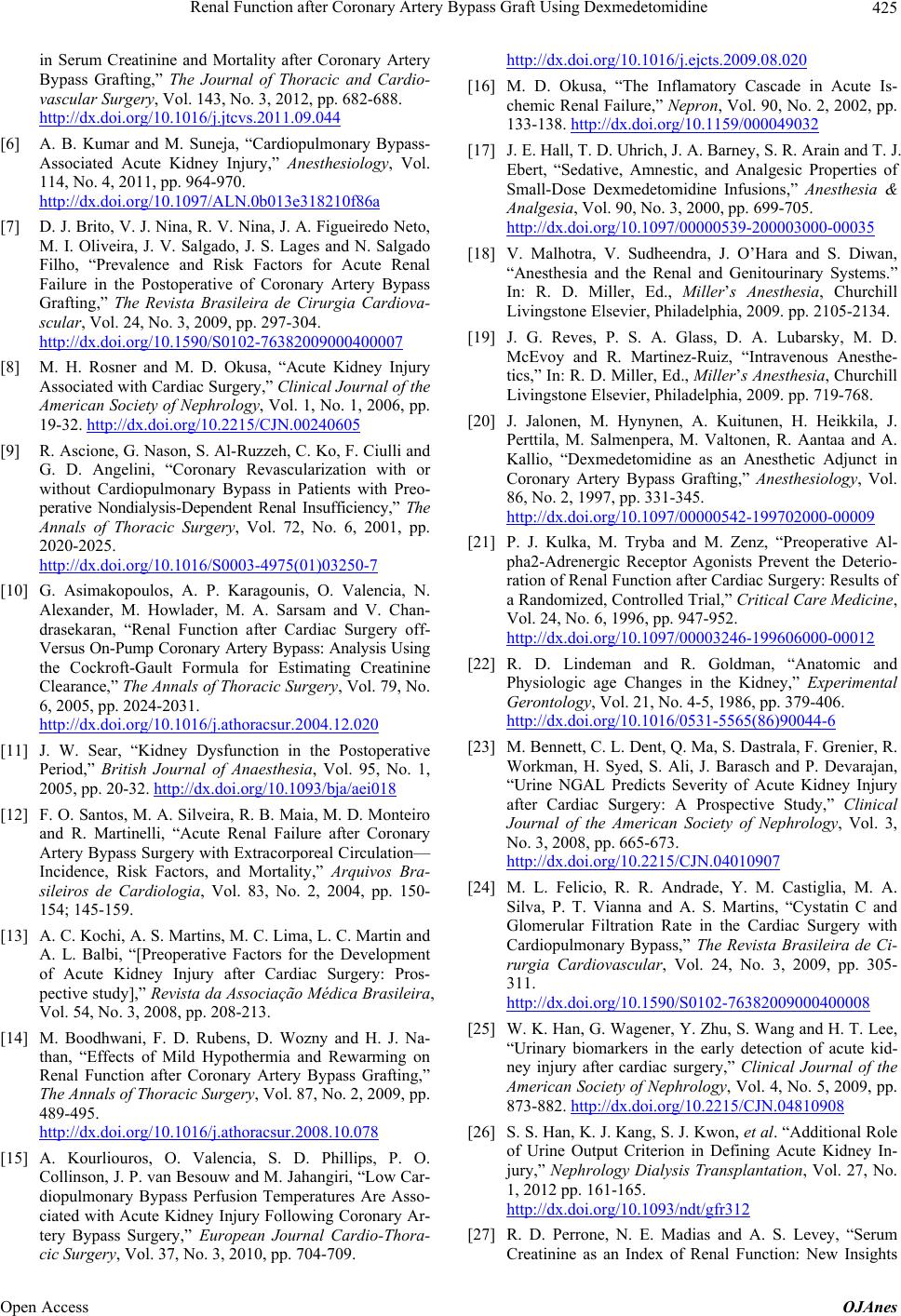
Renal Function after Coronary Artery Bypass Graft Using Dexmedetomidine 425
in Serum Creatinine and Mortality after Coronary Artery
Bypass Grafting,” The Journal of Thoracic and Cardio-
vascular Surgery, Vol. 143, No. 3, 2012, pp. 682-688.
http://dx.doi.org/10.1016/j.jtcvs.2011.09.044
[6] A. B. Kumar and M. Suneja, “Cardiopulmonary Bypass-
Associated Acute Kidney Injury,” Anesthesiology, Vol.
114, No. 4, 2011, pp. 964-970.
http://dx.doi.org/10.1097/ALN.0b013e318210f86a
[7] D. J. Brito, V. J. Nina, R. V. Nina, J. A. Figueiredo Neto,
M. I. Oliveira, J. V. Salgado, J. S. Lages and N. Salgado
Filho, “Prevalence and Risk Factors for Acute Renal
Failure in the Postoperative of Coronary Artery Bypass
Grafting,” The Revista Brasileira de Cirurgia Cardiova-
scular, Vol. 24, No. 3, 2009, pp. 297-304.
http://dx.doi.org/10.1590/S0102-76382009000400007
[8] M. H. Rosner and M. D. Okusa, “Acute Kidney Injury
Associated with Cardiac Surgery,” Clinical Journal of the
American Society of Nephrology, Vol. 1, No. 1, 2006, pp.
19-32. http://dx.doi.org/10.2215/CJN.00240605
[9] R. Ascione, G. Nason, S. Al-Ruzzeh, C. Ko, F. Ciulli and
G. D. Angelini, “Coronary Revascularization with or
without Cardiopulmonary Bypass in Patients with Preo-
perative Nondialysis-Dependent Renal Insufficiency,” The
Annals of Thoracic Surgery, Vol. 72, No. 6, 2001, pp.
2020-2025.
http://dx.doi.org/10.1016/S0003-4975(01)03250-7
[10] G. Asimakopoulos, A. P. Karagounis, O. Valencia, N.
Alexander, M. Howlader, M. A. Sarsam and V. Chan-
drasekaran, “Renal Function after Cardiac Surgery off-
Versus On-Pump Coronary Artery Bypass: Analysis Using
the Cockroft-Gault Formula for Estimating Creatinine
Clearance,” The Annals of Thoracic Surgery, Vol. 79, No.
6, 2005, pp. 2024-2031.
http://dx.doi.org/10.1016/j.athoracsur.2004.12.020
[11] J. W. Sear, “Kidney Dysfunction in the Postoperative
Period,” British Journal of Anaesthesia, Vol. 95, No. 1,
2005, pp. 20-32. http://dx.doi.org/10.1093/bja/aei018
[12] F. O. Santos, M. A. Silveira, R. B. Maia, M. D. Monteiro
and R. Martinelli, “Acute Renal Failure after Coronary
Artery Bypass Surgery with Extracorporeal Circulation—
Incidence, Risk Factors, and Mortality,” Arquivos Bra-
sileiros de Cardiologia, Vol. 83, No. 2, 2004, pp. 150-
154; 145-159.
[13] A. C. Kochi, A. S. Martins, M. C. Lima, L. C. Martin and
A. L. Balbi, “[Preoperative Factors for the Development
of Acute Kidney Injury after Cardiac Surgery: Pros-
pective study],” Revista da Associação Médica Brasileira,
Vol. 54, No. 3, 2008, pp. 208-213.
[14] M. Boodhwani, F. D. Rubens, D. Wozny and H. J. Na-
than, “Effects of Mild Hypothermia and Rewarming on
Renal Function after Coronary Artery Bypass Grafting,”
The Annals of Thoracic Surgery, Vol. 87, No. 2, 2009, pp.
489-495.
http://dx.doi.org/10.1016/j.athoracsur.2008.10.078
[15] A. Kourliouros, O. Valencia, S. D. Phillips, P. O.
Collinson, J. P. van Besouw and M. Jahangiri, “Low Car-
diopulmonary Bypass Perfusion Temperatures Are Asso-
ciated with Acute Kidney Injury Following Coronary Ar-
tery Bypass Surgery,” European Journal Cardio-Thora-
cic Surgery, Vol. 37, No. 3, 2010, pp. 704-709.
http://dx.doi.org/10.1016/j.ejcts.2009.08.020
[16] M. D. Okusa, “The Inflamatory Cascade in Acute Is-
chemic Renal Failure,” Nepron, Vol. 90, No. 2, 2002, pp.
133-138. http://dx.doi.org/10.1159/000049032
[17] J. E. Hall, T. D. Uhrich, J. A. Barney, S. R. Arain and T. J.
Ebert, “Sedative, Amnestic, and Analgesic Properties of
Small-Dose Dexmedetomidine Infusions,” Anesthesia &
Analgesia, Vol. 90, No. 3, 2000, pp. 699-705.
http://dx.doi.org/10.1097/00000539-200003000-00035
[18] V. Malhotra, V. Sudheendra, J. O’Hara and S. Diwan,
“Anesthesia and the Renal and Genitourinary Systems.”
In: R. D. Miller, Ed., Miller’s Anesthesia, Churchill
Livingstone Elsevier, Philadelphia, 2009. pp. 2105-2134.
[19] J. G. Reves, P. S. A. Glass, D. A. Lubarsky, M. D.
McEvoy and R. Martinez-Ruiz, “Intravenous Anesthe-
tics,” In: R. D. Miller, Ed., Miller’s Anesthesia, Churchill
Livingstone Elsevier, Philadelphia, 2009. pp. 719-768.
[20] J. Jalonen, M. Hynynen, A. Kuitunen, H. Heikkila, J.
Perttila, M. Salmenpera, M. Valtonen, R. Aantaa and A.
Kallio, “Dexmedetomidine as an Anesthetic Adjunct in
Coronary Artery Bypass Grafting,” Anesthesiology, Vol.
86, No. 2, 1997, pp. 331-345.
http://dx.doi.org/10.1097/00000542-199702000-00009
[21] P. J. Kulka, M. Tryba and M. Zenz, “Preoperative Al-
pha2-Adrenergic Receptor Agonists Prevent the Deterio-
ration of Renal Function after Cardiac Surgery: Results of
a Randomized, Controlled Trial,” Critical Care Medicine,
Vol. 24, No. 6, 1996, pp. 947-952.
http://dx.doi.org/10.1097/00003246-199606000-00012
[22] R. D. Lindeman and R. Goldman, “Anatomic and
Physiologic age Changes in the Kidney,” Experimental
Gerontology, Vol. 21, No. 4-5, 1986, pp. 379-406.
http://dx.doi.org/10.1016/0531-5565(86)90044-6
[23] M. Bennett, C. L. Dent, Q. Ma, S. Dastrala, F. Grenier, R.
Workman, H. Syed, S. Ali, J. Barasch and P. Devarajan,
“Urine NGAL Predicts Severity of Acute Kidney Injury
after Cardiac Surgery: A Prospective Study,” Clinical
Journal of the American Society of Nephrology, Vol. 3,
No. 3, 2008, pp. 665-673.
http://dx.doi.org/10.2215/CJN.04010907
[24] M. L. Felicio, R. R. Andrade, Y. M. Castiglia, M. A.
Silva, P. T. Vianna and A. S. Martins, “Cystatin C and
Glomerular Filtration Rate in the Cardiac Surgery with
Cardiopulmonary Bypass,” The Revista Brasileira de Ci-
rurgia Cardiovascular, Vol. 24, No. 3, 2009, pp. 305-
311.
http://dx.doi.org/10.1590/S0102-76382009000400008
[25] W. K. Han, G. Wagener, Y. Zhu, S. Wang and H. T. Lee,
“Urinary biomarkers in the early detection of acute kid-
ney injury after cardiac surgery,” Clinical Journal of the
American Society of Nephrology, Vol. 4, No. 5, 2009, pp.
873-882. http://dx.doi.org/10.2215/CJN.04810908
[26] S. S. Han, K. J. Kang, S. J. Kwon, et al. “Additional Role
of Urine Output Criterion in Defining Acute Kidney In-
jury,” Nephrology Dialysis Transplantation, Vol. 27, No.
1, 2012 pp. 161-165.
http://dx.doi.org/10.1093/ndt/gfr312
[27] R. D. Perrone, N. E. Madias and A. S. Levey, “Serum
Creatinine as an Index of Renal Function: New Insights
Open Access OJAnes